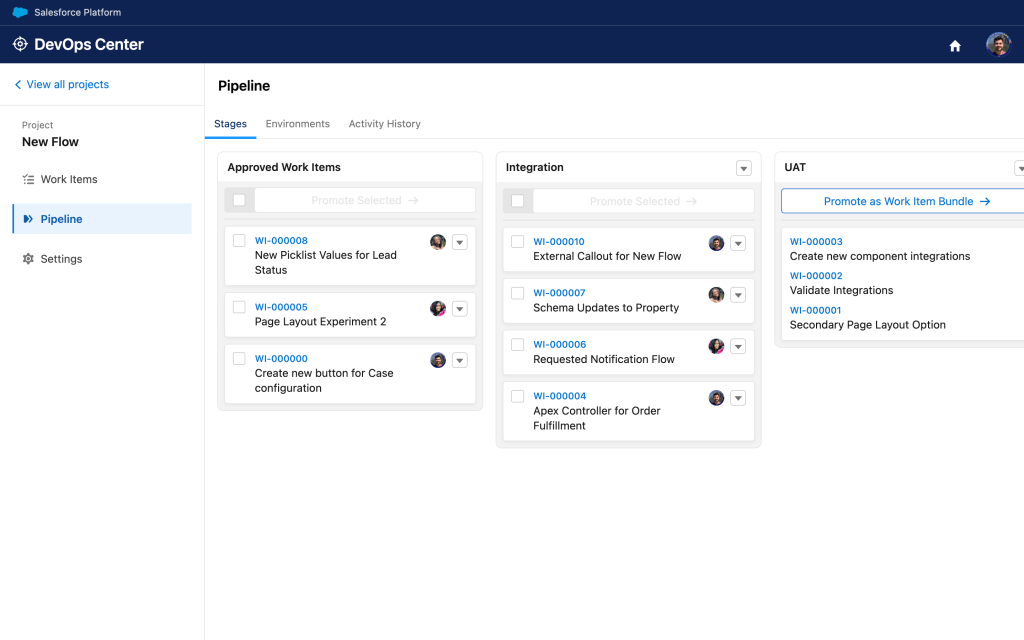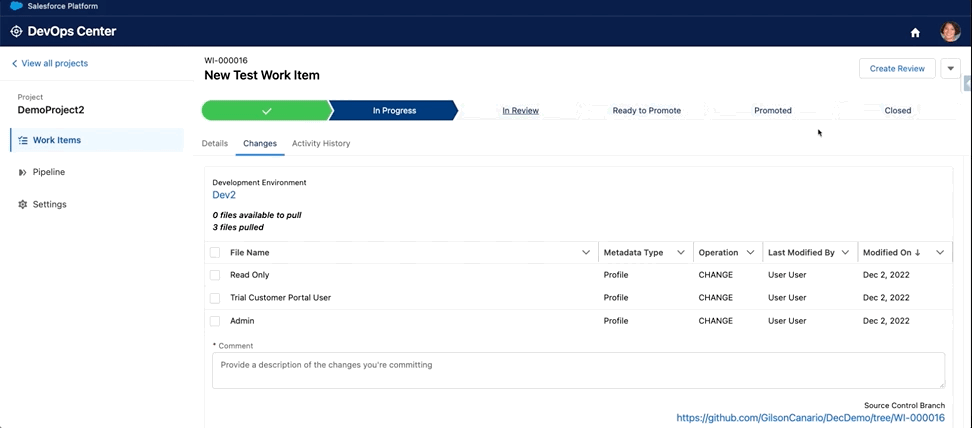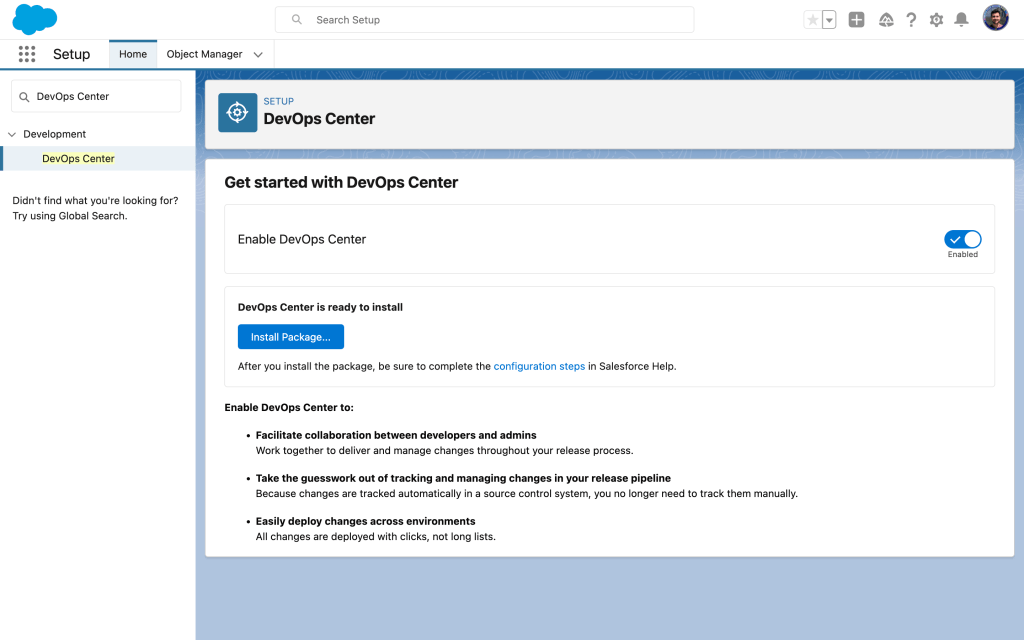Key Takeaways
- The highly anticipated new product accelerates development on the Salesforce Platform to help teams release technology solutions faster, where organizations can reduce IT costs by as much as 25%. Companies that build on the Salesforce Platform deploy solutions 30% faster, and increase developer productivity by 28%*.
- For more detailed technical information about DevOps Center, visit the Salesforce Admins blog or the Developer Blog.
Today, Salesforce announced the general availability of DevOps Center to help teams release technology solutions faster. DevOps Center makes it easier to collaboratively build, test, and deploy custom solutions across Salesforce – including automations, applications, and experiences – that connect to real-time customer data.
Why it matters: At a time when companies are under immense pressure to deliver success now, DevOps Center brings improved tooling to build apps faster and more reliably across sales, service, marketing, commerce, and IT teams — including apps powered by the Genie Customer Data Cloud — which delivers faster time to value:
- IT teams can track the customization of sales processes within visual pipelines and work items, providing their sales leadership stakeholders with visibility into each step of the project.
- Admins can build Flows (automation) within secure sandboxes to automate customer support, while a programmatic developer extends that work with code in their own sandbox, with DevOps Center orchestrating the changes to avoid conflicts.
- Developers can use their preferred tools to customize out-of-the-box financial services solutions, directly committing changes to source control. Their extended team can then see those changes in DevOps Center and iterate on them.
- Release Managers for health businesses can bundle and migrate changes across sandboxes using clicks, delivering better patient experiences faster, and without having to wrangle change sets.
- CIOs can also use DevOps Center to more quickly and easily build apps and Flows powered by the Genie Customer Data Cloud to understand and unlock customer data and deliver actionable insights in real time and at scale.
What’s new: Key features of DevOps Center that reduce the cost and complexity of deployments include:
- Better organized work. Teams can track and deploy the associated changes as Work Items — records on the new, custom object delivered with the DevOps Center application that can be operated against with Salesforce Flows and other platform operations.
- Automated change tracking to accelerate releases. As teams make changes in their sandboxes, DevOps Center automatically tracks them. Users can point and click to promote their desired metadata components, and ignore those that are not relevant. This removes spreadsheets, sticky notes, and change sets as a means to track changes.
- Customized pipelines. Companies can now easily create a pipeline that makes sense for each team and associate stages with sandboxes to build and test.
- Seamless integrations with Source Control. Starting with GitHub, teams can use clicks to connect DevOps Center to their version control systems. This centralizes changes in source, and does so in a way that is friendly for those who don’t have experience with Git, branch management, or Pull Requests. Now teams can enforce DevOps best practices and governance without the typical hurdles.
- Easy ways to migrate and deploy changes with clicks. DevOps Center visualizes the entire development pipeline, and enables teams to bundle and migrate changes from one stage to another with clicks.
- Supports fusion teams: While most associate DevOps with highly technical talent, DevOps Center provides a low-code solution for DevOps best practices, which means that all users, not only highly technical talent, can participate in the development pipeline and deliver business solutions.
By the numbers: For CIOs, IT leaders, admins, developers, and DevOps professionals, DevOps Center provides a single source of truth for projects and work to be done, wrapped in a centralized, easy-to-use interface on top of modern DevOps tooling, such as Git-based version control.
- DevOps Center accelerates development on the Salesforce Platform, where organizations can reduce IT costs by as much as 25%. Those that build on the Salesforce Platform deploy solutions 30% faster, and see as much as a 28%* increase in developer productivity.
- To deliver more value to their stakeholders faster, IT leaders use DevOps practices to increase deployment frequency, reduce average time to resolve incidents, and reduce the rate of change failures.
- With 92% of IT leaders saying their current processes slow down innovation, and 81% saying that their organization struggles with IT complexity, DevOps Center provides technology teams with a simple, transparent development pipeline, promoting greater visibility and traceability across the lifecycle of changes.
- This low-code approach to DevOps enables CIOs to bring their C-suite counterparts closer to innovation, while also maintaining security controls.


The Salesforce perspective: “Businesses are facing economic headwinds, creating tension between speed-to-value and the security of the application lifecycle across sales, service, marketing, commerce, and IT. CIOs and their teams must help their companies do more with the tools and resources at their disposal,” said Karen Fidelak, Senior Director of Product Management, Salesforce.
- “DevOps Center is one of our most-requested and most-anticipated solutions ever because it increases efficiency and productivity – and it makes work easier and more accurate for thousands of development teams. It’s now easier than ever to manage changes, collaborate with team members, and ensure you have a synchronized source. And, it’s designed for fusion teams made up of developers across the low-code and pro-code continuum, so you can work inside or outside the DevOps Center UI-based app and everything remains in sync,” Fidelak continued.
The IBM perspective: “At IBM, we’re focused on fast and efficient releases across Salesforce, and that means we need to stay on top of changes while also keeping our sandbox environments in sync,” said Sarfarajey Akram Mir, Platform Architect at IBM.
DevOps Center enables us to increase the speed and quality of our deployments, while also enabling more of our team to participate in the development lifecycle without fear of code collisions.
Sarfarajey Akram Mir, Platform Architect at IBM
Zoom out: DevOps Center’s GA retires over 75,000 points on the IdeaExchange, Salesforce’s collaborative marketplace for feature ideas, where Trailblazers vote to influence the Salesforce roadmap.
- DevOps Center’s low-code user experience has led to massive adoption during its open beta, with nearly 13,000 unique active users and an average of a deployment every nine minutes.

Go deeper:
- Learn more in Why DevOps Center is Awesome for Salesforce Admins and Get Up and Running with Salesforce DevOps Center Today.
- DevOps Center is a managed package to enable and install in a Professional (API access required), Enterprise, or Unlimited Edition org at no additional cost. It can also be installed in a Developer Edition org, Trailhead Playground, or Scratch Org for evaluation.
- See Salesforce Help: Enable and Install DevOps Center in the Org for installation and configuration instructions, and learn more with these additional resources:
*Source: 2022 Salesforce Success Metrics Global Highlights. A 2022 study based on 3,706 customer interviews in the US, Canada, UK, Germany, France, Australia, India, Singapore, Japan, and Brazil.



















